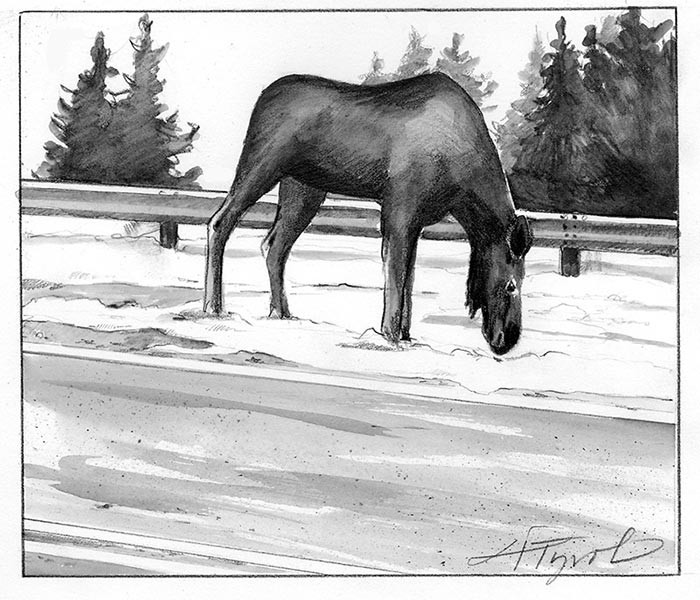
Every so often, my friend David texts me a picture of roadkill. A fisher trailing a single strand of blood-red sinew. A wind-roused pile of porcupine quills. A bobcat in graceful, permanent repose. One year, he built extra time into his schedule so he could stop to document every carcass on his daily commute – 40 critters in all, not including salamanders, snakes, and myriad other wildlife too small to be seen from a moving vehicle.
What David knows, and what I too have come to appreciate, is that roadkill is not mere gore. Roadkill is, in fact, an opportunity, a chance to look closely at the bodies of animals who would otherwise fly, dart, or scamper away from us.
It’s also a growing, and grave, conservation concern. By one estimate, nearly a million vertebrates a day are killed in vehicle collisions in the United States. As drivers, we tend to notice one carcass at a time – and only the big ones that stick around for a while, like deer or raccoons – but there is much more to the story than what we see from behind our windshields.
If you really want to understand the toll automobiles take on wildlife, get out of your car, take a walk down the street, and make a note every time you see a roadkilled animal. Here is what you’ll find: with the exception of rodents and red efts, roadkill is rarely random. Roads near water, for instance, experience many more wildlife fatalities than roads not near water. Rural roads are, for many species, deadlier than highways.
In April, on rainy nights, you’ll find the crumpled remains of soft-bodied frogs and salamanders. In June, you’ll discover crushed turtles, females mostly, who ventured out of the protective mire of their ponds in search of sandy road shoulders in which to lay their eggs. You’ll also see beavers, but just the two-year-olds, who’ve been booted from their family lodges to make room for newborn kits. In September and October, you’ll smell the striped skunks before you see them, their urgent preparations for the cold months ahead having come to a sudden end. In winter, in the North Country, you’ll find moose who went searching for a salt lick and, sadly, found it in road salt.
If you walk your road every day for a year, 95% of the roadkill you encounter will be reptiles and amphibians.
The good news is this: there are solutions, and if we identify the times and places in our communities where roadkill is most concentrated (“hot moments” and “hot spots”), we can make them less lethal. Thanks to extensive private efforts, and federal and state grant support, a well-traveled road in Monkton, Vermont now sports a series of tunnels and fences to guide rare blue-spotted salamanders and other amphibians safely across. At the edge of an urban park in Philadelphia, a neighborhood closes their street to cars for several nights each spring to allow hundreds of toads to migrate to their breeding pond without playing a real-life game of “Frogger.” Wildlife tunnels under Route 2 in Concord, Massachusetts have provided safe passage for at least 32 different species, including humans.
Both Maine and Massachusetts have recently launched statewide roadkill reporting projects, where ordinary folks can share the locations – and, yes, pictures – of roadkilled wildlife with state biologists and transportation planners. This past spring, New Hampshire Fish & Game opened their online wildlife reporting system to roadkill submissions for the first time, too. Biologist Mike Marchand said he made the change because he was “inspired by a roadkilled coyote.”
These endeavors are not new. The first roadkill survey in the United States was undertaken in 1924 by Dr. Dayton Stoner, who was shocked to discover 225 carcasses of 29 species – including 18 thirteen-lined spermophiles (known today in much drabber terms as “ground squirrels”) – while on a four-day drive through Iowa farm country. Stoner published his findings in Science, concluding that “the mania for speed so generally prevalent among automobile drivers” and “the death-dealing qualities of the motor car” were “making serious inroads on our native mammals, birds, and other forms of animal life.”
It’s been nearly a century since Dr. Stoner traveled gravel roads in his Model T counting spermophiles. The world moves faster now, and the impacts of roads on wildlife are more serious still. Thankfully, road ecologists, citizen scientists, and transportation gurus are today working together, lane by lane, to reverse the trend.
The next time you come across an animal whose end was the road, take a moment to contemplate the wild creature before you. Imagine it moving through forest and field, or gently padding along the edge of a cobble-strewn stream. Consider what might have drawn it – and others like it – to the road. Was it seeking food, warmth, a mate? Was it caring for young? Think first like a beaver or fox or barred owl, then like a biologist, and piece together the patterns.


Discussion *